Two months ago, as the coronavirus pandemic was taking hold, we completed our series of blogs on the future of ATM by concluding that despite the current crisis, the need to act remains. If aviation is to be part of the carbon free future, then ATM modernisation is still required. That was in early March before the full scope of the crisis had unfolded. We stand by the need for modernisation but recognise the need to re-plan short term efforts to take account of the serious impact on traffic levels. In this blog we provide further reflection on how priorities are changing.
Existing drivers are still valid
The European ATM Master Plan and the Airspace Architecture Study are supported by a cost benefit analysis based on the positive traffic forecasts of 2018, and the then undoubted benefits of removing escalating delays from a system beginning to creak at the seams. The stark truth is that whilst investing in a growing market is a no brainer; the new reality could be a system operating at lower traffic levels than 2018 for a number of years, making investments in modernisation hard to justify. However, it is important to remember that capacity shortfall was not the only driver for modernisation. As an industry we need to take a step back and decide what really matters and how this has changed. In addition to accommodating new traffic, the drivers for ATM modernisation are:
-
- Support the sustainability of aviation by ensuring aircraft can fly the most optimal trajectory.
- Accommodate new forms of flying to enable new economic activity.
- Embrace disruptive technologies to enable wider performance improvements and cost-efficiency.
These drivers are still valid – and potentially more critical in helping ATM be an enabler of wider economic recovery.
Support sustainability
It is hard to remember that at the beginning of the year, aviation was facing an existential threat that had nothing to do with Coronavirus. Although aviation was growing as an industry, environmental concerns were beginning to limit that growth. The notion of flygskam was affecting public attitudes towards flying. The industry was clear – action was needed to ensure aviation had a “licence to grow”.
ATM was never going to be the whole solution – lighter aircraft, new engines and sustainable fuels will all play a bigger part in the lowering of aviation carbon emissions – but ATM has a strong role by ensuring that all aircraft are able to fly the most optimal trajectory – which can be enabled by the SESAR Trajectory Based Operations concept.
Public attitudes to flying will have been altered by “lockdown” – someone will want to fly more than ever, some may be put off flying for quite a while. Those that live near airports will not want noisy flights to return. The scrutiny of aviation’s environmental credentials will be as fierce as ever – and we in the ATM community need to play our part.
Accommodate new forms of flying
 With most of the manned fleet grounded, the opportunity for drones to support critical services has increased. The need to accommodate drones in the ATM system is no way diminishing with a particular need to focus on enabling operations in the specific category.
With most of the manned fleet grounded, the opportunity for drones to support critical services has increased. The need to accommodate drones in the ATM system is no way diminishing with a particular need to focus on enabling operations in the specific category.
Perhaps the fastest changing business case is Urban Air Mobility. UAM covers both parcel delivery and passengers but this is really two different problems. Parcel delivery requires small drones but needs to be point-to-any-point; Air Taxi is based on larger eVTOL aircraft capable of carrying several passengers (and initially perhaps a pilot) but with a more limited point-to-point network made up of vertiports.
Post-COVID, Air Taxi – particularly with a remote pilot – will be a useful compliment to traditional land transport modes struggling with social distancing rules. An air taxi route can be established much quicker and at lower costs than a new tram or train line and doesn’t need to share the roads with other users vehicles, cyclists and pedestrians. If the “new normal” does include a re-distribution of where we live and work, maybe eVTOL is the answer to changing mobility requirements in an environmentally friendly way.
 Embrace disruptive technologies
Embrace disruptive technologies
Drones and eVTOL are genuinely disruptive technologies, but to the existing business that can be replicated through their use – parcel delivery, pipeline inspection, crowd surveillance or urban mobility. In the future, advances in UAS Traffic Management or UTM may well disrupt how ATM is provided – but in the short term is really an issue of accommodation within the current paradigm.
For a technology to be disruptive to ATM it needs to challenge the way the service is provided enabling new business models that are more cost-effective and sustainable.
Concepts like Virtual Centre, Remote Tower and ATM Data Services have the potential to be disruptive technologies to ATM. They challenge the status quo of where and how ATM is provided. To be beneficially disruptive, they need to be embraced widely. Deploying this type of system without underlying changes to the industry could lead to additional costs without significant benefits.
Reflect the new normal
Whilst there is much current speculation on the future of flying – how long we will wait at airports, whether the middle seat will contain a person or a dividing screen – they are hopefully short term distractions because all they do is suppress traffic; they should have no lasting impact on ATM provision. But new drivers for ATM may emerge as the recovery unfolds along with new attitudes to flying. I believe the most lasting impact of Coronavirus on ATM will be increased regional traffic volatility.
By and large, governments around the world were slow to react – by the time the shutters really came down we already had a global pandemic. Many appeared to adopt a wait and see approach as scientists raced to understand how the disease was spreading. The level of asymptomatic carriers left everyone on the wrong foot – and still seems to confuse our politicians. It is a lesson that will be hard to forget. States are much more likely to play it safe and close borders quickly when an unknown disease emerges; the travelling public are also likely to make decisions on where to take holidays based on their perception of risk – possibly reducing traffic quicker and for longer than State restrictions.
The result will be a different and more dynamic distribution of traffic than we are used to. Geo-political events moving key traffic flows – for example, the ongoing conflict in Eastern Ukraine – cause issues for ANSPs who have to adapt to large swings in traffic. Change in traffic patterns is now likely to be more frequent – requiring individual ANSPs to offer more scalable and resilient services.
New realities require a new plan
It is good practice, but difficult, to differentiate between priority and urgency. Whilst the urgency for short term capacity gain may have evaporated, it does not alter the longer term priority for a wide ranging transformation of ATM to deliver cost-efficient services supporting sustainable aviation and new forms of air vehicle using modern technology.
Re-planning is necessary. The short term focus has to be managing reduced traffic as cost-efficiently and sustainably as possible. This can be achieved by optimising ATM within the current paradigm. Some short term elements, like airspace re-design, can be postponed unless they are required to reduce environmental impacts.
But we must not use Coronavirus as an excuse to delay necessary reform. ATM needs to implement Trajectory Based Operations for the environment – and the European ATM Master Plan and Airspace Architecture Study remain the most viable approach in Europe to achieve this objective in a cost-efficient manner.

Author: Paul Ravenhill, Technical Director


Recent Comments